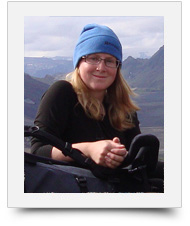 Nichole Moerhuis
Nichole Moerhuis
PhD student
University of British Columbia
Magmatic differentiation processes (fractional crystallization, assimilation, magma mixing, silicate immiscibility and volatile transport) are the mechanisms by which a single melt produces a range of igneous rock types, and they are vital for the formation of Layered Intrusions. We have many outstanding questions concerning magmatic differentiation in Layered Intrusions: How long does it takes for these intrusions to cool and crystallize at different scales? How does the melt chemically evolve during late-stage crystallization? As Layered Intrusions commonly form as part of large continental plumbing system connecting mantle melting and surficial flood basalt provinces, what can their timing and chemical evolution tell us about the evolution of Large Igneous Provinces and the occurrence of mass extinction events they are associated with?
To try and answer these questions, my research applies a petrographic, geochemical (trace element geochemistry, Hf isotopes) and geochronological (CA-TIMS U-Pb) tool-box to the Paleocene Skaergaard Intrusion in East Greenland. Skaergaard has been a classic testing ground for magmatic processes since the 1930’s because it cooled and crystallized as a closed-system during magmatism in the North Atlantic Igneous Province and has since become beautifully exposed by glaciation, making it a fantastic natural laboratory to examine magmatic differentiation processes. Whereas the vast majority of prior research into the magmatic evolution of layered intrusions has focused on early forming ‘primocryst’ minerals, my research involves examining highly differentiated interstitial melt pockets of minerals that have crystallized under near-solidus conditions and include a suite of U-Th-Pb bearing accessory minerals such as zircon, apatite and rutile. This enables us to gain new insights into near-solidus processes, and utilize high-precision CA-TIMS U-Pb dating of zircon to resolve magmatic timescales to tens of thousands of years! With high-resolution emplacement and crystallization ages, shallow level magmatism in the East Greenland Flood Basalt plumbing system can be linked to regional events such as the continental breakup of the North Atlantic and potentially to the Paleocene-Eocene Thermal Maximum (PETM).
This PhD research is based at the University of British Columbia and the Pacific Center for Isotopic and Geochemical Research with Drs. James Scoates and Dominique Weis, and in collaboration with Dr. Christian Tegner at Aarhus University, Denmark. CA-TIMS geochronology is undertaken at the Pacific Center for Isotopic and Geochemical Research and Boise State University.
I am from the South Island of New Zealand and my interest in geology began as I explored my beautiful backyard – the Southern Alps. I completed an Bachelor’s Degree in Geology at the University of Otago (New Zealand) with a component of study at Haskoli Islands (University of Iceland) in 2012. As an undergraduate, I focused upon palaeontology and examined Tertiary perturbations in sea level within sedimentary sequences from Central Otago. My MSc thesis (University of Otago, 2013-14) examined the metamorphism, mineralization and deformation of a Paleozoic amphibolite schist (the Onekaka Schist) in northwest Nelson, New Zealand. This project initiated my interest in geochronology and geochemistry as tools to unravel geological processes.
Last updated January 2015


 Catherine Armstrong
Catherine Armstrong Laura Bilenker
Laura Bilenker Priyanka Chandan
Priyanka Chandan Carol Cheyne
Carol Cheyne June Cho
June Cho Sarina Cotroneo
Sarina Cotroneo Jamie Cutts
Jamie Cutts Fiona D'Arcy
Fiona D'Arcy Ashley Davidson
Ashley Davidson Nicolas Estrade
Nicolas Estrade Anaïs Fourny
Anaïs Fourny Evelyn Frères
Evelyn Frères Elizabeth King
Elizabeth King Alexander Lemieux
Alexander Lemieux Miling Li
Miling Li Marc-Antoine Longpré
Marc-Antoine Longpré Gregor Lucic
Gregor Lucic Kalina Malowany
Kalina Malowany Eduardo Mansur
Eduardo Mansur Jill McDermott
Jill McDermott Rhy McMillan
Rhy McMillan Aleksandra Mloszewska
Aleksandra Mloszewska Nichole Moerhuis
Nichole Moerhuis Emily Mullen
Emily Mullen Genna Patton
Genna Patton Jean-David Pelletier
Jean-David Pelletier Elizabeth Phillips
Elizabeth Phillips Nabila Rahman
Nabila Rahman Lindsay Reynolds
Lindsay Reynolds Luiz Felipe Salim Amaral
Luiz Felipe Salim Amaral Cheyenne Sica
Cheyenne Sica Elliott Skierszkan
Elliott Skierszkan Kate Smith
Kate Smith Natalie Szponar
Natalie Szponar Victoria Tweedie
Victoria Tweedie Tom Ver Hoeve
Tom Ver Hoeve Clara Waelkens
Clara Waelkens Nicole Williamson
Nicole Williamson Anne Wozney
Anne Wozney Wang Zheng
Wang Zheng


 Site by Sprout Creative
Site by Sprout Creative